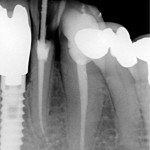
The Swedish Council on Health Technology Assessment (SBU) systematic review of the Methods of Diagnosis and Treatment in Endodontics is now available in English, the original report in Swedish being published in 2010. The review aimed to address a number of specific questions:-
- How well can different diagnostic methods determine the condition of the pulp in teeth with different types of injury (caries, trauma, restorative interventions and other causes)?
- How well can different radiographic methods demonstrate loss of bone at the root apex?
- Are there effective methods for treating pulpal inflammation so that the pulp can be preserved when it has been subjected to caries, trauma or other injury?
- How effective are different treatment measures when the pulp is necrotic (dead)?
- How effective are orthograde (root filling through the crown) and retrograde (surgical intervention at the root apex) treatments of root filled teeth showing signs of periapical inflammation (apical periodontitis)
- How effective are different methods for treatment of acute toothache?
- Can the root filled tooth be restored effectively, with long-term survival of the tooth and the restoration?
- Is there a risk that cases of acute and chronic infection originating in the dental pulp may cause pathological conditions in other organs?
- What serious side-effects are associated with root canal therapy?
- Which are the most cost-effective methods for diagnosis and treatment of diseases of the dental pulp?
The SBU use robust methodologies similar to those employed by NICE and SIGN in the addressing their reviews. For those with a particular interest in this area full review is well worth a thorough read. The main conclusions of the review were:-
Because of the lack of studies it is not possible to determine which diagnostic methods can disclose whether a vital but injured pulp can be maintained or whether it should be removed and replaced with a root filling. The available research provides limited direction as to what distinguishes a treatable from a non-treatable pulpal inflammation(pulpitis).
The effects of different methods used for instrumentation, disinfection and root filling associated with root canal therapy are insufficiently investigated.
An investigation of common practice among Swedish dentists shows that great variations exist in treatment strategies and choice of materials. This applies, for example, to the management of the exposed pulp or when a root filling is retreated. An exception is the use of engine driven instrumentation, which to a varying degree is used by almost two-thirds of the dentists.
There is a need for prospective studies of root canal therapy, which show how teeth can be preserved in the long-term, without risk of recurrence of symptoms, peri-radicular inflammation or tooth fracture. The lack of good research in this field clearly indicates that priority should be given to well-planned and carefully conducted clinical studies of methods for diagnosis and treatment of the disease conditions of the pulp.
There is a need for a national registry with quality indicators to be applied for follow-up evaluations of pulpal and root canal treatments.
Comment
While the report comments on great variations in the treatment strategies and choice of materials of Swedish dentists this variation is likely to be present in other countries. Also, what is clear from this review is that despite lengthy clinical experience we lack a high quality evidence base to underpin the methods we use for endodontic treatment and diagnosis. However, as we are increasingly learning from the work of the SBU, The Cochrane Oral Health Group and other guideline developers this is not the only area of dentistry where we need to improve the quality of our evidence.
Links
SBU – Methods of Diagnosis and Treatment in Endodontics
SBU – Swedish Council on Health Technology Assessment
